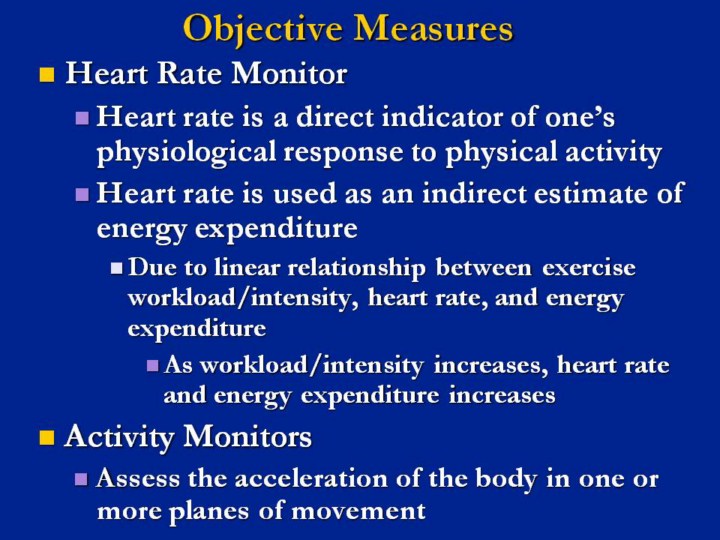| front |1 |2 |3 |4 |5 |6 |7 |8 |9 |10 |11 |12 |13 |14 |15 |16 |17 |18 |19 |20 |21 |22 |23 |24 |25 |26 |27 |28 |29 |30 |31 |32 |33 |34 |35 |review |
 |
Heart Rate Monitors are used to assess heart rate response. PROS. Heart rate monitoring is valid in both laboratory and field settings. Also, there is low participant burden for short monitoring periods. Heart rate monitoring is able to provide information relating to workload/intensity, frequency, and duration of physical activity for adult populations. It is an easy and quick method making it practical for large studies. CONS. Heart rate monitoring can be expensive, there may be possible patient discomfort if the monitoring period is lengthy, and it is only useful for aerobic (cardiovascular) activities. Finally, characteristics of heart rate, especially among trained individuals, may affect the relationship between heart rate and energy expenditure and may lead to inaccurate results.
Activity Monitors, often referred to as accelerometers, assess the acceleration of the body in a specific dimension (uniaxial) or multiple dimensions (triaxial). The monitors provide information on the intensity of acceleration at specified intervals. Following data collection, this information is downloaded to a computer for data processing. PROS. Objective measure of body movement that has been found to be valid in both laboratory and free-living settings. Activity monitors have the ability to provide information relating to intensity, frequency, and duration of physical activity. They are also non-invasive and have the ability to record over extended periods of time. CONS. They are costly and do not provide information concerning activity type. Also, the uniaxial monitors may be inaccurate during upper-body movements and during bicycling. Most activity monitors are not waterproof; therefore, water-based activities cannot be assessed. Also, improper monitor placement may lead to inaccurate results.
Recommended Reading: Welk GJ (2002). Physical activity assessments for health-related research. Champaign, IL: Human Kinetics. |